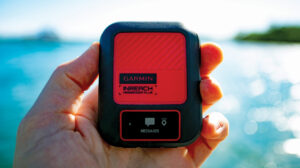Gyrocompasses
Just like a toy gyroscope, the gyro tries to keep its axle pointing in the same direction in space. In other words, if it starts spinning with its axle pointing toward a star that is rising over the eastern horizon, it will try to tilt upwards as the star rises.

Precession is a curious characteristic of gyroscopes. It means that if you try to divert the axis of the spinning rotor, it will move at right angles to the force you apply. So if the gyroscope is mounted so that it cannot tilt upwards to track the rising star, it will react by “precessing” until it points north-south. At that point, it stops precessing, because once its axle is parallel to the spin axis of the earth, it can keep pointing in the same direction in space without having to tilt.
Gyrocompasses are immune from variation and deviation, so they are the heading reference of choice in ships. Unfortunately they are heavy, bulky, and very expensive, and take several hours to “run up” before they are ready to use. So they aren’t really a practical proposition for owners of recreational craft.
A gyro-assisted compass is completely different: It usually refers to a flux-gate compass that incorporates a rate gyro to stabilize its output.
This article originally appeared in the July 2011 issue of Power & Motoryacht magazine.










